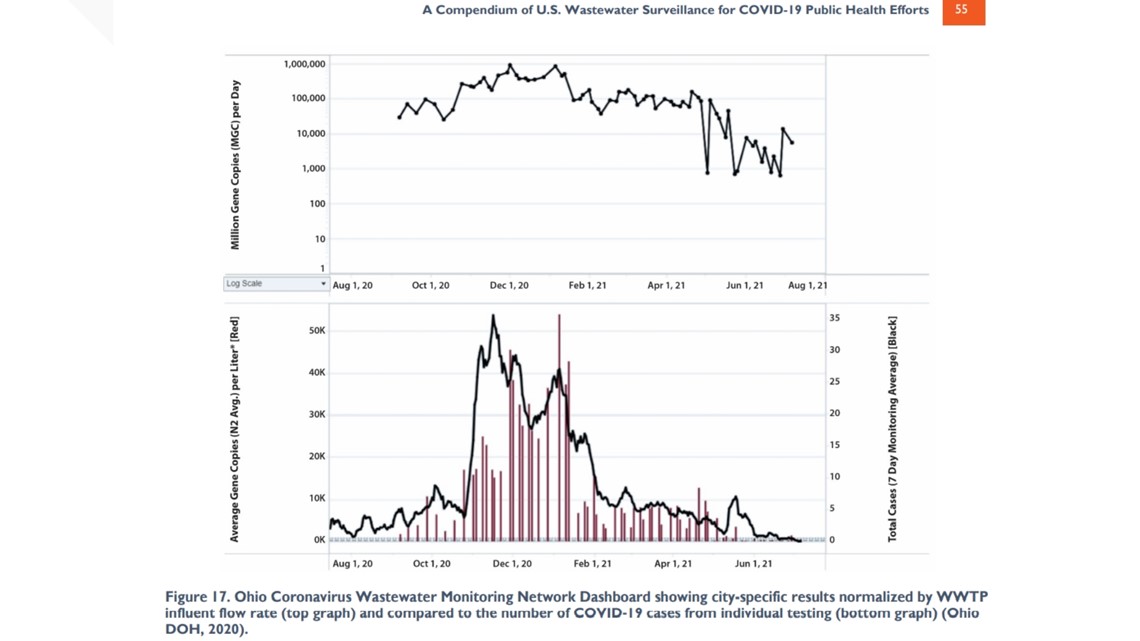COLUMBUS, Ohio — Ohio was among the first of what is now the vast network of at least 37 states studying when the next wave of COVID-19 might strike.
And scientists are focusing on human waste as a possible key indicator.
According to the state’s coronavirus website, research in the U.S. and elsewhere has shown that non-infectious RNA (ribonucleic acid) from the virus that causes COVID-19 (called SARS-CoV-2) can be excreted in the feces of both symptomatic and asymptomatic infected people and can be detected in wastewater as many as three to seven days before those infections lead to increases in case counts or hospitalizations.
By monitoring wastewater, scientists argue this can serve as an early warning of disease increase in a community. That can lead to increase testing or other mitigation efforts to help curb the spread.
Below is a snapshot of COVID in Franklin County since the beginning of the pandemic.
Notice our largest waves happened last winter and over the summer with the delta wave.
Monitoring our wastewater seemed to pick up on each of these crests in the days before cases increased, according to a 10 Investigates’ review of the data.


A series of emails obtained by 10 Investigates also appears to confirm this.
In a November 23, 2020 email that the Ohio Department of Health sent to both Columbus Public Health and Franklin County Health, the state warned that wastewater results from a Franklin County wastewater treatment plant had shown the “highest levels of average gene copies... to date.”
Those samples were collected on November 11, 15th and 17th of 2020.
On November 14, 2020, Franklin County recorded more than 600 cases.
By November 23 of that year - when the email reached the Columbus and Franklin County Health Departments - cases peaked at more than 1,200 – just in Franklin County – on one single day.
The collaborative effort by Ohio State University, Kent State University and others who are part of the Ohio wastewater monitoring network have also predicted other spikes.
In an email sent July 12, 2021, the Ohio Department of Health warned of a “recent increase in viral gene copies at the Jackson County wastewater treatment plant.”
In the email obtained by 10 Investigates, wastewater data collected in early July started to show an increase in traces of COVID-19 genes in human waste.
If you refer back to our map above, Franklin County recorded just 36 cases on July 6.
By the next week, they had doubled.
By the end of July when the Delta wave was still in its earliest stages of ascending, cases in Franklin County had risen to 136 on July 31.
These two graphs, published in a report by the U.S. EPA, shows how closely correlated the detection of COVID in wastewater is to future case counts:


Earlier this month, 10 Investigates was granted access to the Ohio State University lab where university scientists are tracking the coronavirus in our wastewater.
Inside the lab overseen by Dr. Jiyoung Lee, university doctoral and graduate students work to filter the wastewater down – removing anything that’s larger than a virus. The goal is to ensure that the sampling can get an accurate measure of COVID-19 gene particles in the community. There are several steps in the lab that are necessary to prepare the sample that ultimately ends up being tested using a PCR method – a highly sensitive and accurate measure of COVID-19 that has been considered the “gold standard” of tests among health officials.
The advantage of this research, Lee says, is that it can provide predictive capabilities and perhaps even provide early detection warning when a COVID-19 wave is about to spike.
In a practical sense, measuring wastewater down to the manhole level can help university officials determine if there is a COVID-19 outbreak in one dormitory over another – and thus be able to provide more testing or mitigation efforts to those areas.
“So based on our wastewater result so we can tell whether the population in that building has no virus infection or if it is a high level, ok a lot of people are getting infected. And we can tell them ok this is a hotspot,” Lee said.
More than 70 wastewater treatment plants – including two that serve Columbus – are a part of the statewide network.
Zuzana Bohrerova with the Ohio Water Resource Center at Ohio State University is responsible for working to collect and assemble the data and provide it to the Ohio Department of Health.
The Ohio Department of Health then sends “alerts” to local health departments, letting them know if there is an uptick in viral gene copies of COVID-19.
On Thursday, 10 Investigates obtained new emails from the Lucas County Health Department – indicated that there was an uptick in viral gene copies on October 25 and October 28.
While Lucas County cases rate is below its neighboring counties, seven of those surrounding counties – like Williams, Van Wert, Defiance, Putnam, Seneca, Fulton and Henry – currently have some of the highest standardized averages for COVID-19 in the entire state.

